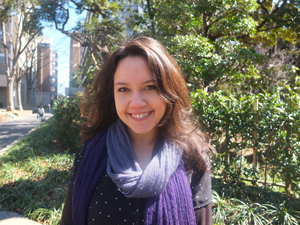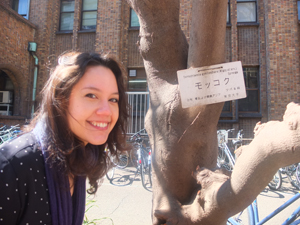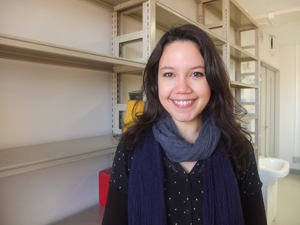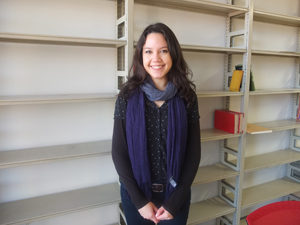Faculty Interview 37
Wulan Remmelink
(Research PhD thesis/Scaliger Fellow University of Leiden)

―― Would you tell me the subject of your research?
The theme of my research is botanical illustrations during the Edo period in Japan. I’m looking into the role botanical illustrations played in the development of the study of botany. Early in the Edo period, the study of botany, as we know it today, did not exist. They had a field of study called honzôgaku 本草学 (materia medica) but that is not equivalent to ‘botany’. I’m using botanical illustrations as an instrument to see the transition from honzôgaku to shokubutsugaku 植物学 (botany). Many people have looked into the history of medicine in Japan and the influence the West had on it, but the study of botany, which focuses on only plants, has not been studied as much. So, I’m trying to trace the development of the study of botany in Japan by looking at the changes and developments of the botanical illustrations themselves.
―― What are the differences between honzôgaku and botany?

To put it simply, honzôgaku (materia medica) is a study that includes plants, animals and even minerals (usually for their medicinal value) whereas botany, or shokubutsugaku in Japanese, is the study of plants in general. Only plants. During the early stages of honzôgaku, Japanese scholars turned to China as their role model and used the Honzô kômoku 『本草綱目』 (Bencao ganmu, in Chinese, by Li Shizen 李時珍) almost like a “bible” for the study of honzô. Japanese scholars studied the plants in the Honzô kômoku and compared them to the plants available in Japan. After a while, however, scholars began to notice that some of the plants mentioned in the Honzô kômoku didn’t exist in Japan and that some plants present in Japan were not mentioned at all. This prompted scholars like Kaibara Ekiken (author of Yamato honzô 『大和本草』) to actively go out to the fields and observe, collect, name and catalogue plants. What we see during the Edo period is a trend amongst scholars to observe and study the natural world which led to a development in the study of natural history (博物史). Then, with the introduction of Western scientific (illustrated) books and the Linnaean system of naming plants in the latter half of the Edo period, scholars like Udagawa Yôan began to focus on a specific field of study of plants, which is botany.
―― Then, what is the relation between this transition and the botanical illustrations?

There is a very close relationship between this transition and botanical illustrations. When I started to study the illustrations in Japanese botanical sources, I noticed how as the study of ‘botany’ progressed, the illustrations also improved, in the sense that they became more scientifically accurate. At the beginning, most scientific information was documented in the form of text. In fact, scholars first thought that illustrations were misleading. But then people started to realize the value of illustrations and the importance of visual argumentation, so they began to represent information about the plants visually. For example, if you compare the illustrations in the Honzô kômoku to the illustrations in sources from the latter half of the Edo period, you can see a clear difference. Earlier botanical illustrations were rather amateurish and not accurate, while later illustrations are more refined, detailed and scientifically accurate. The main aim of botanical illustrations is to communicate scientific information, so accuracy is essential.
During my Masters, I started to see a kind of parallel development in the artistic world and scientific world. The illustrations in Western books brought by the Dutch caught the eyes of the Japanese scholars and painters. It was a more realistic way of representing objects in nature. Together with the introduction of new drawing and painting skills and new scientific techniques and knowledge, Japanese sciences developed at quite a fast rate.

―― I felt interested in the perspective, the parallel development in the artistic world and scientific world!
Thank you. Sometimes my research is difficult to explain. When people ask me what the theme of my research is, I answer that it is about early 19th century Japanese botanical illustrations, but unfortunately, sometimes they don’t understand. My research topic is very interdisciplinary. It is a study that deals with art and science and East-West relations. My research has two levels. I’m looking at the role of botanical illustrations in the development of botany in Japan, while also looking at the role botanical illustrations played in the exchange of scientific information and the circulation of knowledge and skills between Japan and the Netherlands during the 18th-19th centuries.
―― You used the words “exchange” and “circulation”. So were these knowledge and skills introduced not only from Holland to Japan, but also from Japan to Holland?

Yes. It’s not just a one-way track but both benefited from this intercultural exchange. The Japanese were introduced to new knowledge and skills, which helped develop their sciences. For example, they learned how to classify and name plants using the Linnaean binomial system – which is still used today. Japanese scholars selectively adopted what they thought was useful and, before long, they were using the same botanical nomenclature as botanists in Europe, and producing similar botanical illustrations.
The scientists and botanists in Europe were very interested in the plants of the East. So when the Dutch went back to the Holland, they brought these “new” plants with them, which also helped to develop the study of botany in Europe. By the way, did you know that almost 70% of the flowers you see in Western gardens came from Japan? And of course botanical illustrations played a very important role because sometimes the live plants didn’t survive the long voyage back to Europe by sea. They needed documentation. So the drawings had to be very accurate for them to understand what the plants were!
I think we have to keep in mind that: a) Japan already had the basic foundations for the study of botany and other sciences and b) the Japanese scholars and artists didn’t simply adopt everything but selected what they thought were useful. I think Japanese scholars were very receptive and creative. For example, the Dutch were also in Indonesia, and a number of Westerners were in other areas of Asia. Then, why didn’t the sciences in these areas develop as they did in Japan? I hope to look into this question someday.
the interviewer’s postscript
The theme of her research is botanical illustrations during the Edo period, so it is very simple and clear. But, because the progress of botanical illustrations related with both the area of science and the area of arts, I think her research includes and covers some areas widely. And she also considers the history of the exchange between the East and the West at a meta-level. I enjoyed this interview very much. Thank you! (Tomoka MUSHIGA)

